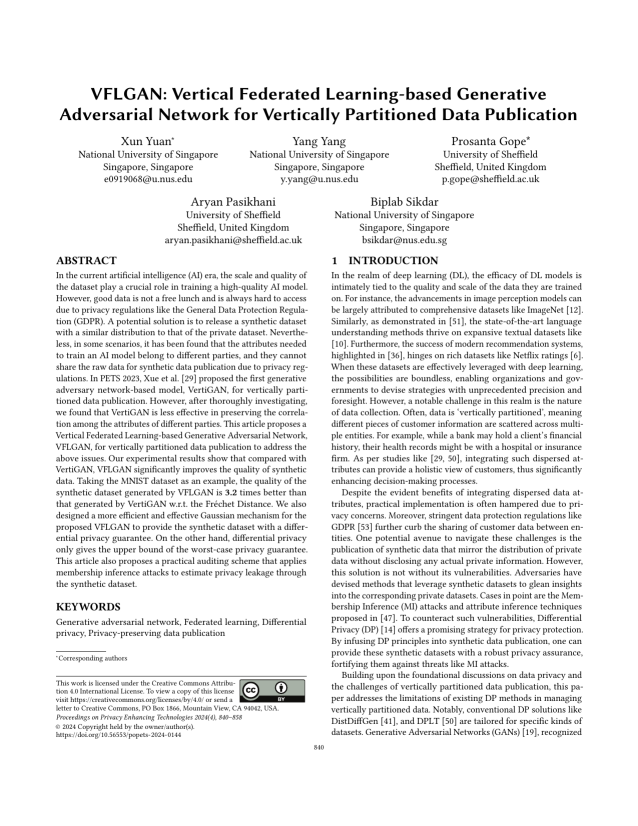VFLGAN: Vertical Federated Learning-based Generative Adversarial Network for Vertically Partitioned Data Publication
Authors: Xun Yuan (National University of Singapore), Yang Yang (National University of Singapore), Prosanta Gope (University of Sheffield), Aryan Pasikhani (University of Sheffield), Biplab Sikdar (National University of Singapore)
Volume: 2024
Issue: 4
Pages: 840–858
DOI: https://doi.org/10.56553/popets-2024-0144
Abstract: In the current artificial intelligence (AI) era, the scale and quality of the dataset play a crucial role in training a high-quality AI model. However, good data is not a free lunch and is always hard to access due to privacy regulations like the General Data Protection Regulation (GDPR). A potential solution is to release a synthetic dataset with a similar distribution to that of the private dataset. Nevertheless, in some scenarios, it has been found that the attributes needed to train an AI model belong to different parties, and they cannot share the raw data for synthetic data publication due to privacy regulations. In PETS 2023, Xue et al. [29] proposed the first generative adversary network-based model, VertiGAN, for vertically partitioned data publication. However, after thoroughly investigating, we found that VertiGAN is less effective in preserving the correlation among the attributes of different parties. This article proposes a Vertical Federated Learning-based Generative Adversarial Network, VFLGAN, for vertically partitioned data publication to address the above issues. Our experimental results show that compared with VertiGAN, VFLGAN significantly improves the quality of synthetic data. Taking the MNIST dataset as an example, the quality of the synthetic dataset generated by VFLGAN is 3.2 times better than that generated by VertiGAN w.r.t. the Frechet Distance. We also designed a more efficient and effective Gaussian mechanism for the proposed VFLGAN to provide the synthetic dataset with a differential privacy guarantee. On the other hand, differential privacy only gives the upper bound of the worst-case privacy guarantee. This article also proposes a practical auditing scheme that applies membership inference attacks to estimate privacy leakage through the synthetic dataset.
Keywords: Generative adversarial network, Federated learning, Differential privacy, Privacy-preserving data publication
Copyright in PoPETs articles are held by their authors. This article is published under a Creative Commons Attribution 4.0 license.

